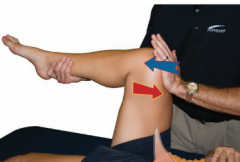![]()
![]()
![]()
Use LEFT and RIGHT arrow keys to navigate between flashcards;
Use UP and DOWN arrow keys to flip the card;
H to show hint;
A reads text to speech;
5 Cards in this Set
- Front
- Back
|
When assessing the psoas Major, what is the joint position being tested?
|

Hip flexion
|
|
|
When assessing the psoas major, what are the muscles being tested?
|

1. Illacus, psoas major
2. Rectus femoris, sartorius, TFL, Adductor longus, gluteus minimus, anterior glute medius |
|
|
When assessing the psoas, what are the potentially overactive muscles, if strength is limited
|

1. Adductor magnus, medial hamstring complex
2. Adductor longus, adductor brevis, pectineus, gracilis |
|
|
When assessing the psoas, how should the client be positioned?
|

supine with hip and knee flexed-thigh in slight external rotation and abduction
|
|
|
When assessing the psoas, what are the movement impairments as demonstrated by the overhead squat assessment?
|

Low back rounding
|

